Kniphofia coddiana
Kniphofia coddiana Cufod.
Family: Asphodelaceae
Common names: Codd’s poker (Eng.)
Introduction
Codd’s poker has a striking appearance with bold spikes of reddish-orange and yellow flowers in spring. This is one of the Near Threatened species of Kniphofia. It is known from fifteen locations in coastal Pondoland where it is under severe threat due to ongoing habitat degradation caused by overgrazing, alien invasive plants and a deleterious fire regime. Its preferred habitat is grassy areas among rocks. It is very similar to K. littoralis and K. drepanophylla.
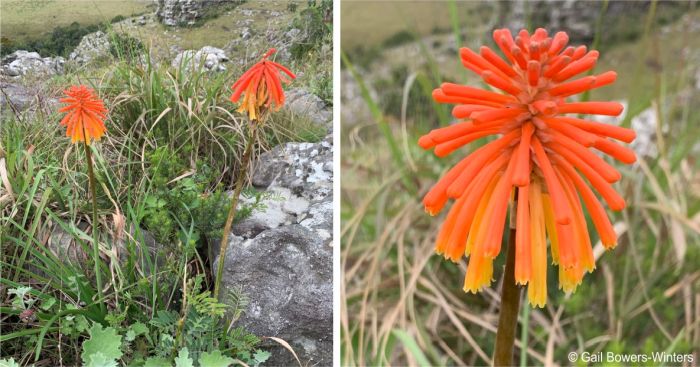
Description
Description
A herbaceous rhizomatous perennial plant with few- to several-stems that grows 400-600 mm in height, forming small groups. Its relatively narrow, erect, strap-like leaves are dull, glaucous green, reaching up to 600 mm long and 8-15 mm wide. The flowers are tubular, 28-32 mm long and 5 mm wide at the throat, red in bud, rarely yellow in bud, becoming orange-yellow to yellow when mature, and are arranged in dense, globose heads, 50–70 mm long, 50-60 mm wide, at the tip of a stalk 400-600 mm tall. Fruit is a globose capsule up to 8x9 mm. Its flowering time is in winter to spring, from June to August until October.
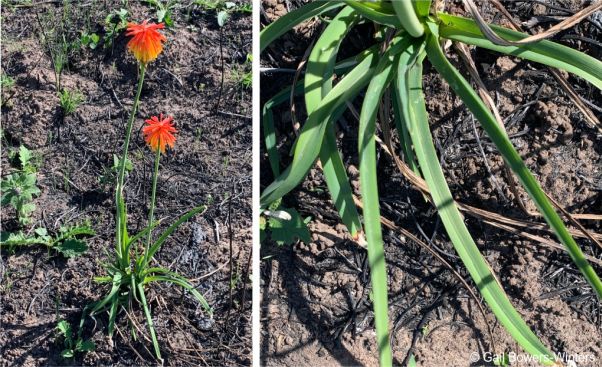
Conservation Status
Status
According to the Red List of South African Plants, the conservation status of this species is assessed as Near Threatened (NT). Although the population size is unknown, at least 55% of its habitat has been lost to agriculture, both commercial (sugarcane and fruit trees) and communal farming, and the expansion of rural settlements. Most of the subpopulations of this species are currently protected and face minimal threats. However, its subpopulations outside the protected areas are at risk because habitat loss from the expansion of rural settlements continues and the degradation of this species' habitat persists due to frequent, uncontrolled and often aseasonal fire, overgrazing of remnant grassland patches by cattle, harvesting for medicinal purposes and the proliferation of alien invasive plants. The population size of K. coddiana is unknown, but a decline is inferred from ongoing loss and degradation outside protected areas. Monitoring is essential to assess the impact of grazing and fires on the populations of this species.
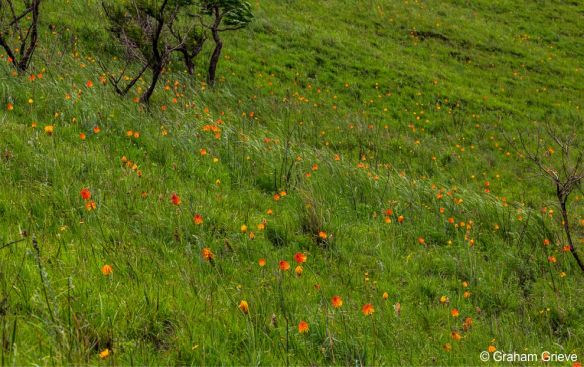
Distribution and habitat
Distribution description
Kniphofia coddiana is endemic to the Pondoland region in northern Eastern Cape and the southern part of the Port Shepstone District in KwaZulu-Natal. This species is documented in 15 locations between Mkambati and Oribi Gorge where it grows mainly in grass among sandstone rocks at altitudes of 70-300 m. The species is very similar to K. drepanophylla and K. littoralis but can be differentiated by its globose fruits.
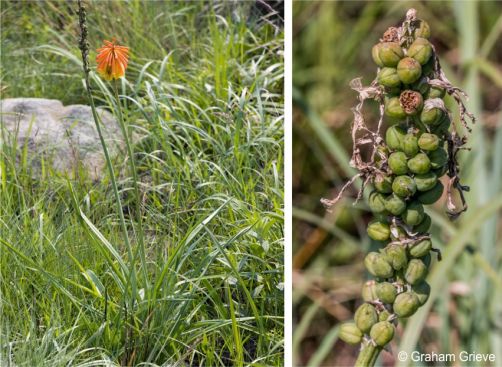
Derivation of name and historical aspects
History
The genus Kniphofia, which includes the plants commonly known as red hot pokers, was named in honour of Johannes Hieronymus Kniphof, 1704-63, who was Professor of Medicine at Erfurt University, Germany. Kniphofia belongs to the family Asphodelaceae, which comprises 17 genera (10 of which occur in South Africa) and about 750 species. About 71 species of Kniphofia occur in Africa, and 48 of these are found in South Africa. For a genus that is so instantly recognisable in gardens, it may be surprising to find that Kniphofia have been grown regularly in cultivation for the last 150 years. Although Europeans first became aware of Kniphofia in the 17th century, soon after colonisation of the Cape of South Africa, it was not until the mid-19th century that the genus became a regular feature in gardens.
Kniphofia coddiana was first described in 1968 and the date of its introduction into cultivation is unknown. The species does not appear to be in general cultivation and its subtropical, coastal origin suggests that it may struggle in colder climates. When Codd described this species in 1968, he used the name K. elegans but was not aware that the name was already used for an Ethiopian species. It was therefore renamed by Cufodontis in 1972 with a name to commemorate Codd himself.
Ecology
Ecology
Kniphofia coddiana flowers provide nectar and pollen for bees and many other pollinating insects. Nectar-feeding birds, such as sunbirds, also feed from Kniphofia flowers and play a role in pollination.
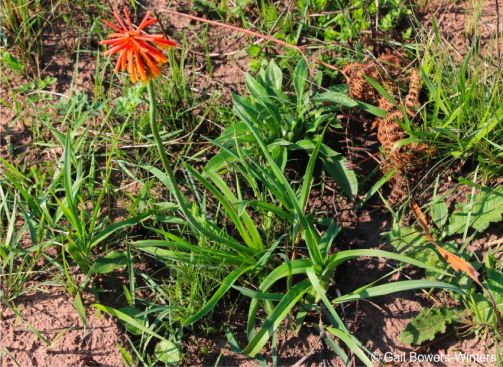
Uses
Use
Many species of Kniphofia are traditionally used for medicinal purposes and are believed to have antioxidant and anti-inflammatory properties which are thought to be effective in treating various conditions, including respiratory problems, stomach-aches, and as a general tonic. However, more scientific studies are needed to support these claims.
Growing Kniphofia coddiana
Grow
Grow Kniphofia coddiana in well-drained, rich soil located in an open, sunny position or in partial shade. This species requires plenty of water during the growing season (spring and summer) if they are to thrive and flower well. They should also be fertilised monthly during their active growing period for best performance. In its subtropical habitat, Kniphofia coddiana is evergreen, but it is frost hardy in South Africa, surviving freezing temperatures by dying down in winter and resprouting in spring. In very cold climates, it requires protection during winter. In cultivation, Kniphofia resent disturbance. Kniphofia coddiana is ideally suited to permanently or seasonally wet grassy areas, around ponds or water features, as well as rockeries, mixed beds and borders. Also suitable for containers.
Kniphofia coddiana can be propagated by division or seed. Large clumps can be divided and planted directly into the ground, although it is best to pot them and grow them on until they are well established. Seeds can be sown in spring, and they normally germinate in about 2 months. Once they have germinated, place the seedlings into their pots. Grow them on in the greenhouse for at least their first winter and plant them out into their permanent positions in late spring.
It grows best in moist, but well-drained soil; both loam and sandy soil are recommended mediums since they allow excess water to drain away, as poor drainage can be detrimental. The soils must be slightly acidic to neutral in pH, and they must receive full sun or partial shade. It is essential to plant Kniphofia coddiana in well-draining soil to prevent root rot and ensure healthy growth.
References
- Bowers-Winters, G. 2023-Nov. Observation of Kniphofia coddiana, uMtamvuna Nature Reserve, KZN. iNaturalist. Online. https://www.inaturalist.org/observations/189775910.
- Bowers-Winters, G. 2024-Oct. Observation of Kniphofia coddiana, Ugu, KZN. iNaturalist. Online. https://www.inaturalist.org/observations/245416915.
- Bowers-Winters, G. 2025-Jul. Observation of Kniphofia coddiana, Ugu, Port Edward, KZN https://www.inaturalist.org/observations/302799963.
- Cloete, E. 2004. A floristic study of a portion of the Pondoland Centre of Endemism, Port St Johns, South Africa. Unpublished MSc thesis, Rhodes University, Grahamstown.
- Codd, L.E. 1968. The South African species of Kniphofia. Bothalia 9: 363–513.
- Diriba, T.F. and Deresa, E.M. 2022. Botanical description, ethnomedicinal uses, phytochemistry, and pharmacological activities of genus Kniphofia and Aloe: A review. Arabian Journal of Chemistry 15: 1–14.
- Grieve, G. 2017-Oct. Observation of Kniphofia coddiana, Rossmin, Ugu District KZN. iNaturalist. Online. https://www.inaturalist.org/observations/215906295.
- Grieve, G. 2020-Oct. Observation of Kniphofia coddiana, Rossmin, KZN. iNaturalist. Online. www.inaturalist.org/observations/82678453.
- Grieve, G. 2022-Oct. Observation of Kniphofia coddiana, uMtamvuna, KZN. iNaturalist. Online. https://www.inaturalist.org/observations/138261316.
- Ramdhani, S. 2006. Evolutionary and biogeographic studies in the genus Kniphofia Moench (Asphodelaceae). Doctoral dissertation. Rhodes University, Grahamstown.
- Scott-Shaw, C.R. & Victor, J.E. 2021. Kniphofia coddiana Cufod. National Assessment: Red List of South African Plants. https://redlist.sanbi.org/species.php?species=2207-13.
- Stern, M. 2002. Kniphofia Moench (Asphodelaceae). PlantZAfrica. Online. http://pza.sanbi.org/kniphofia-species.
- Whitehouse, C. 2016. Kniphofia the complete guide. Royal Horticultural Society: RHS Media. Peterborough.
Credits
Ndumiso Hlongwane and Sabelo Msimango
Pretoria National Botanical Garden
August 2025
Acknowledgements: images by Graham Grieve and Gail Bowers-Winters from their observations posted on iNaturalist.
Plant Attributes:
Plant Type: Bulb
SA Distribution: Eastern Cape, KwaZulu-Natal
Soil type: Sandy, Loam
Flowering season: Spring, Winter
PH: Acid
Flower colour: Red, Yellow, Orange
Aspect: Full Sun, Morning Sun (Semi Shade), Afternoon Sun (Semi Shade)
Gardening skill: Average
Special Features:
Horticultural zones
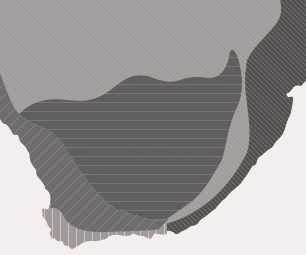






Rate this article
Article well written and informative
Rate this plant
Is this an interesting plant?
Login to add your Comment
Back to topNot registered yet? Click here to register.